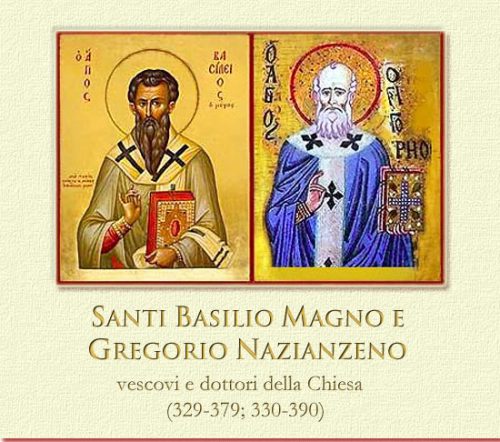
Saint Basil the Great
Saint Basil was born in Asia Minor. Two of his brothers became bishops, and with his mother and his sister, are honored as Saints. He studied with great success in Athens, where he formed a tender and perpetual friendship with Saint Gregory Nazianzen. He then taught oratory. The study of philosophy had already raised him above all worldly ambition, and dreading the honors of the world, he gave up all things to become the father of monastic life in the East. His older sister, Saint Macrina, encouraged him when he abandoned the greater part of his inheritance.
He retired into Pontus, where his sister was Superior of a convent, into which his mother also had entered; there he founded a monastery on the opposite side of the river from the convent, and governed it for four years, from 358 to 362. He founded several other religious houses in the same region, both for men and for women. It was for them that he composed his ascetic works, including his famous Rule, still followed by the monks of the Orient.
He then resigned, leaving his office to his brother, Saint Peter of Sebastus, to retire in prayer. Saint Gregory came to join his friend for a time, in response to his invitation. Ever afterwards, Basil would recall with regret the peace and happiness they had enjoyed, singing Psalms, studying Scripture, keeping vigil in prayer, and disciplining their flesh by manual work. It was only in 363 that this holy hermit was ordained a priest by Eusebius of Caesarea in Cappadocia.
The Arian heretics, supported by the court, were then persecuting the Church, and Basil was summoned from his retirement by his bishop to give aid against them. His energy and zeal soon mitigated the disorders of the Church, and his solid and eloquent words silenced the heretics. On the death of Eusebius, he was chosen Bishop of Caesarea. His commanding character, his firmness and energy, his learning and eloquence, seconded by his humility and the great austerity of his life, made him a model for bishops. He founded in Caesarea a vast hospital, which Saint Gregory called a new city and which remained in existence for long decades. He went there often to console the suffering, and help them to make good use of their pains.
When Saint Basil was summoned by the emperor Valentius to admit the Arians to Communion, the prefect in charge, finding that soft words had no effect, said to him, Are you mad, that you resist the will before which the whole world bows? Do you not dread the wrath of the emperor, nor exile, nor death? No, said Basil calmly; he who has nothing to lose need not dread loss of goods; you cannot exile me, for the whole earth is my home; as for death, it would be the greatest kindness you could bestow upon me; torments cannot harm me; one blow would end both my frail life and my sufferings. The prefect answered, Never has anyone dared to address me thus. Perhaps, suggested Basil, you never before measured your strength with a Christian bishop. The emperor desisted from his commands.
Saint Basil’s entire life was one of suffering, both physical and moral; he lived amidst jealousies, misunderstandings and seeming disappointments. But he sowed the seed which bore good fruit in the future generations. He was God’s instrument to resist the Arian and other heretics in the East, and to restore the spirit of discipline and fervor in the Church. He died peacefully in 379 at the age of fifty-one, and is venerated as a Doctor of the Church.
Saint Gregory Nazianzen
Saint Gregory was born in 312 near Caesarea of Cappadocia, of parents who are both honored as Saints, and the infant was immediately consecrated to God. After learning all that he could in his native land, he journeyed to Caesarea in Palestine to study at the famous school founded by Origen, then went to Alexandria in Egypt to rejoin his brother there. After some time he embarked for Athens, the metropolis of the sciences and the humanities. During the voyage, a storm of twenty days’ duration nearly caused the loss of the ship and all passengers; their safe arrival in Athens was attributed to Saint Gregory’s prayers, and all aboard adopted Christianity.
In Athens he met and became the close friend of Saint Basil, and these noble souls turned away together from the most attractive worldly prospects. For some years they lived in seclusion, self-discipline, and studious labor, knowing only two roads, Gregory wrote, one to church, the other to school. Only after thirty years of studies and good works in Athens did they leave that city and separate. They would meet again in the year 358, to live in solitude for a time in the Province of Pont.
Saint Gregory was raised to the priesthood almost by force, preaching his first sermon, after a ten-weeks’ retreat, on the dangers and responsibilities of the priesthood. In 372, when he was sixty years old, he was consecrated a bishop by his dear friend Saint Basil, who had become Archbishop of Caesarea in Cappadocia. All their lives they would correspond; many of Saint Gregory’s noble and eloquent letters to Saint Basil can still be read among the 212 pieces of his correspondence which are still conserved.
Saint Gregory’s rare gifts and conciliatory disposition had become well known. In the year 379, when he was sixty-seven years old, he was chosen to be Patriarch of Constantinople. That city was distracted and laid waste in those times by Arian and other heretics. After a reception which was at best lukewarm, the new Patriarch labored there successfully, from his base in a small church named the Anastasia (Resurrection), where he gave instructions and saw the number of his listeners increase daily.
The Arians were so irritated at the decay of their heresy that they pursued the Saint with outrage, calumny and violence, and at length resolved to take his life. For this purpose they chose an intrepid youth who was willing to undertake the sacrilegious commission. But God did not allow him to carry it out; he was touched with remorse and cast himself at the Saint’s feet, avowing his sinful intent. Saint Gregory forgave him at once, treated him with all kindness and received him among his friends, to the wonder and edification of the whole city and to the confusion of the heretics, whose crime had served only as a mirror to the virtue of the Saint.
Saint Jerome states that he himself learned at the feet of this master, who was his catechist in Holy Scripture. But Saint Gregory’s humility, his austerities, the humble appearance of his aging and worn person, and above all his very success in Constantinople, did not cease to draw down upon him the hatred of every enemy of the Faith. He was persecuted by the magistrates, stoned by the rabble, and thwarted and deserted even by his brother bishops. During the second General Council, hoping to restore peace to his tormented city, the eloquent bishop, whom the Church calls Saint Gregory the Theologian, resigned his see and retired to his native town, where he died in the year 390.
Source: sanctoral.com
